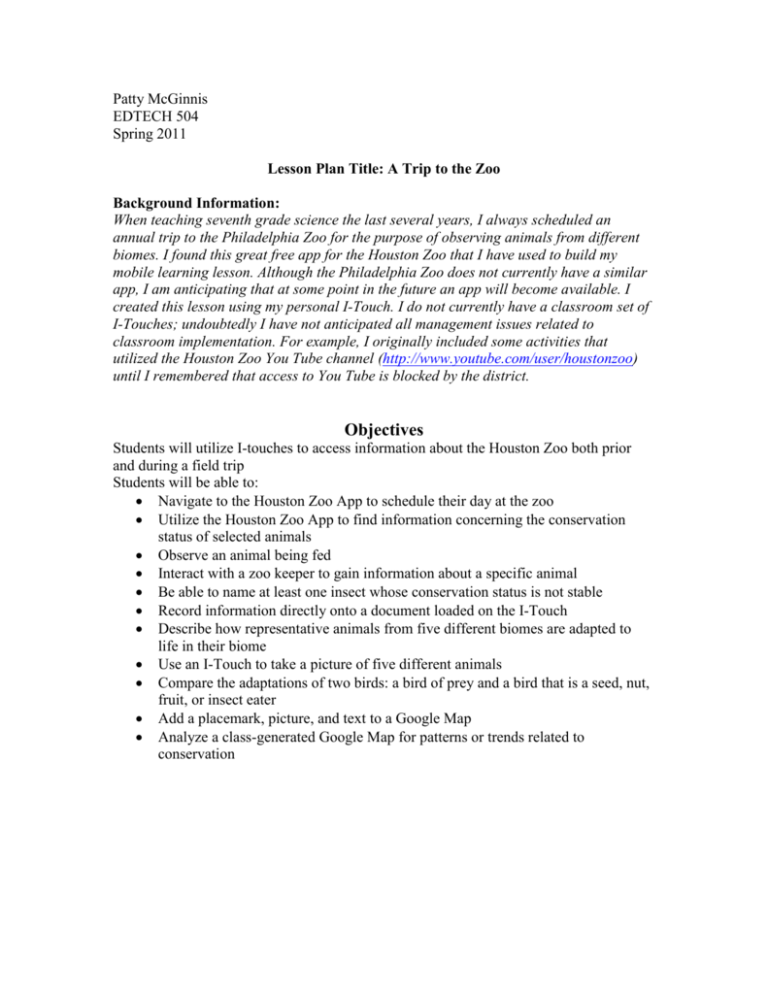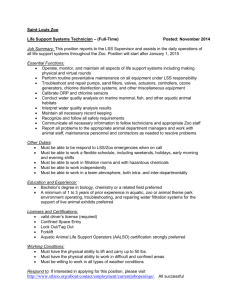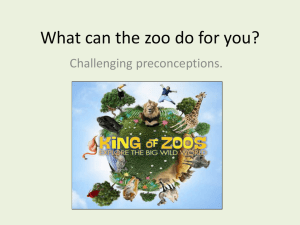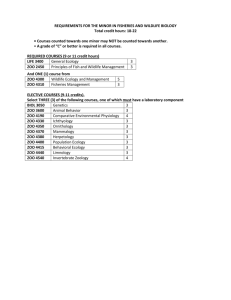McGinnis_Lesson_Plan_Activity_Final
advertisement

Patty McGinnis EDTECH 504 Spring 2011 Lesson Plan Title: A Trip to the Zoo Background Information: When teaching seventh grade science the last several years, I always scheduled an annual trip to the Philadelphia Zoo for the purpose of observing animals from different biomes. I found this great free app for the Houston Zoo that I have used to build my mobile learning lesson. Although the Philadelphia Zoo does not currently have a similar app, I am anticipating that at some point in the future an app will become available. I created this lesson using my personal I-Touch. I do not currently have a classroom set of I-Touches; undoubtedly I have not anticipated all management issues related to classroom implementation. For example, I originally included some activities that utilized the Houston Zoo You Tube channel (http://www.youtube.com/user/houstonzoo) until I remembered that access to You Tube is blocked by the district. Objectives Students will utilize I-touches to access information about the Houston Zoo both prior and during a field trip Students will be able to: Navigate to the Houston Zoo App to schedule their day at the zoo Utilize the Houston Zoo App to find information concerning the conservation status of selected animals Observe an animal being fed Interact with a zoo keeper to gain information about a specific animal Be able to name at least one insect whose conservation status is not stable Record information directly onto a document loaded on the I-Touch Describe how representative animals from five different biomes are adapted to life in their biome Use an I-Touch to take a picture of five different animals Compare the adaptations of two birds: a bird of prey and a bird that is a seed, nut, fruit, or insect eater Add a placemark, picture, and text to a Google Map Analyze a class-generated Google Map for patterns or trends related to conservation Instructional Activities Pre-Trip 1. Follow Mrs. McGinnis’ directions to access this document and import it into your I-Touch. Open this document in Docs To Go (you will be recording answers onto the document via the I-Touch) 2. Download the Houston Zoo App available at http://www.houstonzoo.org/iphone-app/ 3. Find two animals featured in the Lion King and use the animal button on the Houston Zoo App to learn about them (Hint: Timon and Pumbaa). How do these animals defend themselves from predators? 4. Your group needs to select five animals that they would like to observe while at the zoo. Use the animal tab on the Houston Zoo App to help you decide (be sure to watch some of the videos). Note that you must select animals that represent each of the different biomes listed in the table below. Record their conservation status and why you selected them into the chart below on your I-Touch. Save your work. Name of Animal Biome Conservation Why We Selected Status/Include Reason if This Animal Threatened or Endangered Grasslands Rain Forest Desert Tundra Freshwater 5. Use the animal tab of the Houston Zoo App to look up the Honeypot Ant. Note that the honeypot ant conservation status is threatened. a. Using what you have learned from reading about animals and their conservation status, predict why the honeypot ant’s conservation status is threatened b. Use the Internet to find out if your prediction is correct. Was it? If not, what is the real reason the honeypot ant is threatened? 6. Type in www.houstonzoo.org. Click on “Eat at the Zoo” to plan where you would like to eat on the day of the field trip. Record your decision below: The Day of the Field Trip 1. Plan your day at the zoo! Open the Houston Zoo App. You will use the “today” button to plan your day and the Maps button to plan your route. 2. Working with your group, select a Keeper Talk that sounds interesting to you and add it to “My Schedule” 3. Select an Animal Feeding activity that you would like to observe and add it to “My Schedule.” 4. Use the Map to find the 5 animals your group wants to observe. Plan a route that will take you each animal without a lot of back-tracking Things to Do During the Day 1. Attend the Keeper Talk Take a picture during the Keeper talk. Ask the keeper a question about the animal (keep it appropriate!). Record some facts you learned from the keeper in the space below: 2. Watch a Feeding Take a picture of the animal that is being fed. Record the name of the animal and what it eats in the space below: 3. Observe Animals from Different Biomes Find the five animals your group decided they wanted to observe. Fill in the chart below to include at least TWO adaptations the animal has for surviving in its biome (Hint: you may have to ask a keeper). Take a picture of each animal. You may also record a podcast or video of the animal if you wish. Name of Animal Biome Adaptations for Biome 4. Compare Two Birds Observe a bird that is a predator (such as a hawk) and a bird that eats seeds, nuts, fruits, or insects. Do not use birds you already observed! Use the Houston Zoo App to find information about the birds or attend a Keeper Talk to learn even more. List at least three adaptations each bird has for survival. Include points such as how the bird is adapted for eating, escaping from enemies, and/or attracting mates. Bird Name Adaptations Post Trip 1. Select three of your five animals that you would like to feature on a group Google Map. 2. Open the class Google Map and insert a placemark on the location in the world where you would find the animals in the wild. Use a red placemark for endangered animals, a yellow placemark for threatened animals, and a green placemark if the animal population is stable. 3. Upload the animal pictures to the class wiki (or other designated site) 4. Add the picture to Google Map by navigating to its online location 5. Add some some text about the animal’s conservation status and how the animal is adapted for its biome. 6. Save the map 7. Once each group has added their placemarks and information, examine the map. a. Describe any patterns you see b. Propose a reason why the pattern(s) exist c. Are there certain biomes that have more endangered species than others? d. Do you have suggestions for improving the status of endangered and threatened species? Application to Learning Theory This lesson, which utilizes a guided inquiry approach, is constructivist in nature; students work in cooperative groups to create meaning about animals, animal adaptation, and conservation. The activity has been scaffolded using a guided inquiry process worksheet which asks the students to perform specific tasks (Kirschner, Sweller, & Clark, 2006). The use of the worksheet will assist students in their task management skills and ensure that learning objectives are met. This cooperative learning activity falls within the coconstructivist dimension, requiring discussion and cooperation among the group members (Kanuka & Anderson, 1999). I chose a project-based learning approach because I wanted to provide a student-centered activity that would engage students via an authentic context. Observing animals and discussing their behavior with zoo experts will deepen student understanding and increase the likelihood that knowledge will be successfully transferred to new learning situations (Land & Hannafin, 2000). This lesson promotes higher level thinking skills; I have been on many field trips where students run from exhibit to exhibit trying to fill in a scavenger hunt worksheet. Unlike a typical scavenger hunt, students are given the freedom to map out their day and to make decisions regarding what animals they would like to observe and document. The technology, rather than being the focus of the lesson, supports the lesson objectives. The end product, a class-generated Google map, will be analyzed for patterns related to global animal conservation status and will provide an opportunity for students to reflect on their learning. References: Kanuka, H., & Anderson, T. (1999). Using constructivism in technology-mediated learning: Constructing order out of the chaos in the literature. Radical Pedagogy, 1(2). Retrieved March 5, 2011 from http://radicalpedagogy.icaap.org/content/issue1_2/02kanuka1_2.html Kirschner, P. A., Sweller, J., & Clark, R. E. (2006). Why minimal guidance during instruction does not work: An analysis of the failure of constructivist, discovery, problem-based, experiential, and inquiry-based teaching. Educational Psychologist, 41. doi:10.1207/s1536985ep4102_1 Land, S. M. & Hannafin, M. J. (2000). Student-centered learning environments. In D. H. Jonassen & S. M. Land (Eds.), Theoretical Foundations of Learning Environments (pp.123). Mahwah, NJ: Lawrence Erlbaum Associates.






